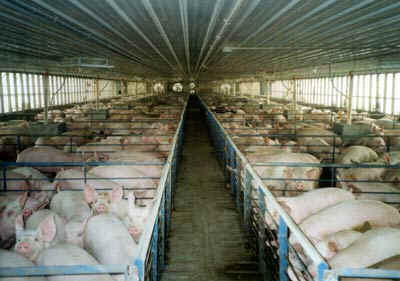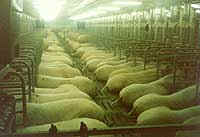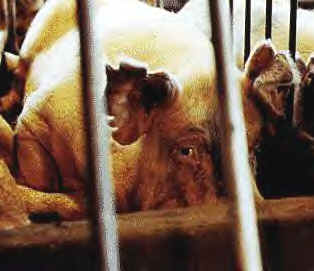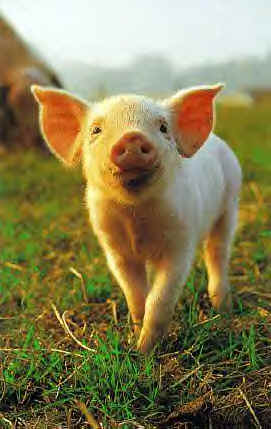|
|
||
|
"With corporate hog factories replacing traditional hog farms, pigs raised for food are being treated more as inanimate tools of production than as living, feeling animals." |
| Approximately 100 million pigs are raised and slaughtered in the U.S. every year. As babies, they are subjected to painful mutilations without anesthesia or pain relievers. Their tails are cut off to minimize tail biting, an aberrant behavior that occurs when these highly-intelligent animals are kept in deprived factory farm environments. In addition, notches are taken out of the piglets' ears for identification. |  |
By two to three weeks of age, 15% of the piglets will have died. Those who survive are taken away from their mothers and crowded into pens with metal bars and concrete floors. A headline from National Hog Farmer magazine advises, "Crowding Pigs Pays...", and this is exemplified by the intense overcrowding in every stage of hog confinement systems. Pigs will live this way, packed into giant, warehouse-like sheds, until they reach a slaughter weight of 250 pounds at 6 months old.
 |
The air in hog factories is laden with dust, dander, and noxious gases, which are produced as the animals' urine and feces builds up inside the sheds. Studies of workers in swine confinement buildings have found sixty percent to have breathing problems, despite their spending only a few hours a day inside confinement buildings. For pigs, who spend their entire lives in factory farm confinement, respiratory disease is rampant. |
Modern hog factories are fertile breeding grounds for a wide variety of diseases. A pork industry report explains:
Porcine Reproductive and Respiratory Syndrome, or PRRS, was first reported in U.S. herds in 1987. It is now estimated to be in as many as 60 percent of U.S. herds... Swine arthritis has increased in economic importance with confinement rearing, partly because of damage related to flooring conditions and partly because of faster growth rates and lack of exercise...The incidence of salmonellosis has continued to increase. It is estimated that one-third to half of farms have some level of salmonellosis... Epidemic transmissible gastroenteritis, or TGE, is a dreaded disease because it's hard to keep out of herds, there's no effective treatment and it carries a devastating mortality rate in baby pigs. Nearly all pigs less than 10 days old die if infected...Forty to 70 percent of U.S. pigs show evidence of infection with bratislava (a type of Leptospirosis)...Tests indicate 80 percent to 85 percent of sows in major swine producing areas have been exposed to parvovirus.
| Modern breeding sows are treated like piglet-making machines. Living a continuous cycle of impregnation and birth, each sow has more than 20 piglets per year. After being impregnated, the sows are confined in gestation crates — small metal pens just two feet wide that prevent sows from turning around or even lying down comfortably. At the end of their four-month pregnancies, they are transferred to similarly cramped farrowing crates to give birth. With barely enough room to stand up and lie down and no straw or other type of bedding to speak of, many suffer from sores on their shoulders and knees. When asked about this, one pork industry representative wrote, "...straw is very expensive and there certainly would not be a supply of straw in the country to supply all the farrowing pens in the U.S." |  |
Numerous research studies conducted over the last 25 years have pointed to physical and psychological maladies experienced by sows in confinement. The unnatural flooring and lack of exercise causes obesity and crippling leg disorders, while the deprived environment produces neurotic coping behaviors such as repetitive bar biting and sham chewing (chewing nothing).
 |
After the sows give birth and nurse their young for two to three weeks, the piglets are taken away to be fattened, and the sows are re-impregnated. An article in Successful Farming explains, "Any sow that is not gestating, lactating or within seven days post weaning is non-active," and hog factories strive to keep their sows '100 % active' in order to maximize profits. When the sow is no longer deemed a productive breeder, she is sent to slaughter. |
In addition to overcrowded housing, sows and pigs are also endure extreme crowding in transportation, resulting in rampant suffering and deaths. As one hog industry expert writes:
Death losses during transport are too high — amounting to more than $8 million per year. But it doesn't take a lot of imagination to figure out why we load as many hogs on a truck as we do. It's cheaper. So it becomes a moral issue. Is it right to overload a truck and save $.25 per head in the process, while the overcrowding contributes to the deaths of 80,000 hogs each year?
Prior to being hung upside down by their back legs and bled to death at the slaughterhouse, pigs are supposed to be 'stunned' and rendered unconscious, in accordance with the federal Humane Slaughter Act. However, stunning at slaughterhouses is terribly imprecise, and often conscious animals are hung upside down, kicking and struggling, while a slaughterhouse worker tries to 'stick' them in the neck with a knife. If the worker is unsuccessful, the pig will be carried to the next station on the slaughterhouse assembly line — the scalding tank — where he/she will be boiled, alive and fully conscious.
The Causation of Eating Pork, Ham and Bacon
